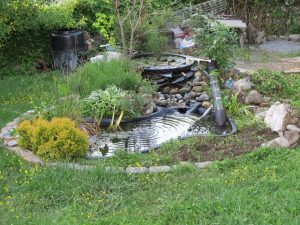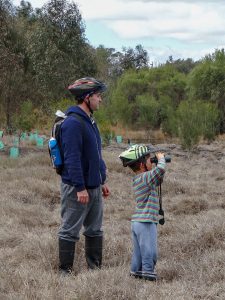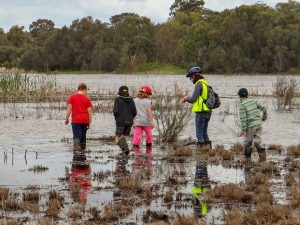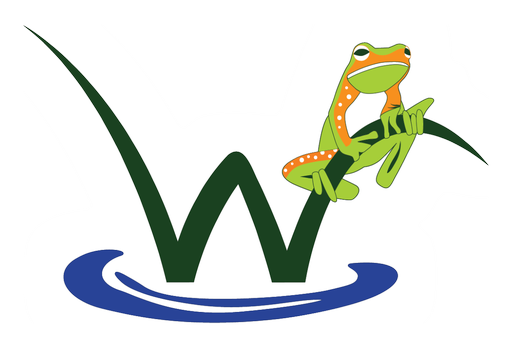Nothing compares to the joy of giving! It is immense. And it is this shared joy and community spirit that are helping us rehabilitate and conserve our vulnerable wetlands.
For, rehabilitating the wetlands is a complex project with many moving parts. Its success relies on the contribution of our volunteers, tireless efforts of wetland staff and vigilance and attention of the active community. We are also fortunate to have many landcare owners and special interest groups that look out for and assist with wetland activity. These people are our heroes!
If you’ve felt like getting involved and contributing, our “Citizen Science” projects are a great place to start. You can work independently on your own initiative, with clear guidance and help from us anytime you need. The activities are interesting and you can see the final build up as collaborators from across the community come forth with their contributions. And finally, the results are made available and published for everyone to see. It is a truly enriching experience.
Here are 5 exciting projects that are currently happening. If you are keen about making a difference and getting involved, we’ve got all the information you need. So, let’s get started!
1. Wildlife Sighting
What is involved: Record your lucky wildlife sightings. This activity involves keeping a lookout for wildlife and their movement through the wetlands and bush.
Our freshwater turtles are predominantly shy creatures that only venture outside their wetland sanctuary during special periods. They are on the move now (from September until January), searching for nesting sites to lay eggs. And soon in June, hatchlings will emerge to make their way back to the wetlands. Our bobtails, quendas and myriad other endangered and/or sensitive wetland creatures too follow a similar pattern.
What you can do:
- Visit ClimateWatch.org.au/mobile and download the app that lets you record your wildlife sightings.
- Whenever you encounter a wild animal, take the time to record your wildlife sighting on the app. Ensure that you maintain a safe distance at all times.
- Visit or call your local wetlands centre for more information.
2. Installing Frog Ponds
What is involved: Creating a natural setting pond ecosystem within your gardens and/or backyards especially catering to the native frog species. This activity involves setting up a beautiful pond at a suitable place at home that attracts the frogs.

Frogs are incredible creatures with well-camouflaged dappled and textured skins, that gleam green, black or brown. And sometimes with vivid patterns to ward off predators. These fragile creatures are seriously endangered and their numbers are dwindling. By installing a frog pond, we are encouraging a growth in their numbers, and in turn, helping our wetland biodiversity.
What you can do:
- Download this document from South Australian EPA with information about this activity and how to install a frog pond. Also, refer to SERCUL’s Gardens for Frogs in Perth Brochure that provides information about frogs and frog ponds specific to Perth.
- Monitor and maintain the frog pond regularly.
- Visit FrogID.net.au to get the FrogID app. Install and use the app to monitor and report frog calls in your pond and around your locality.
- Visit or call your local wetlands centre for more information.
3. Nest box Monitoring
What is involved: Install and monitor nest boxes for bats and other wildlife. This activity involves the installation and monitoring of nest boxes.
Nest boxes with easy Do-It-Yourself instructions are available to be installed at home or in parks around your home. Ensure that you take permission from your local council before proceeding. There is a high risk of feral bees invading and occupying nest boxes. So, ensure that you check for and report feral bee infestation immediately. Check for damage and weathering of boxes regularly. Also, check for animal health whenever, and to the extent possible, without disturbing the inhabiting species.
What you can do:
- Purchase and install the nestbox in an appropriate area. Get permission from your local council before commencing.
- Ensure you do it right by purchasing nest boxes that are expertly designed to inhibit infestation by feral bees, which can be very dangerous.
- Monitor for wildlife – bats, phascogales or possums. It is recommended that you check at least twice a year during January/February and June.
- For information about bat boxes, visit GoBatty.com.au and get in touch with local bat expert, Joe Tonga, who has extensive experience building and installing bat boxes.
- Visit or call your local wetlands centre for more information.
4. Water Monitoring
What is involved: Monitoring the waterbodies – sea or freshwater. This activity involves uploading images of a water source to an app and regularly monitoring it for changes.
‘Eye on Water’, as the project is called, enables people to upload photographs of a target water source to an app. CSIRO has launched an app specifically for this purpose. The app then allows you to match the image using a colour chart and visually determine the quality of water.
The images are subsequently added to a global database that will support scientists in monitoring Australian waters for activity such as algal blooms, nutrient explosion, sediment and salinity levels and seasonal changes.
What you can do:
- Download and install the free CSIRO ‘Eye on Water’ app on your mobile phone.
- Choose a water body to monitor. While you are free to choose any type of water body, we encourage you to choose a wetland. Record your findings using the app.
- Visit or call your local wetlands centre for more information.
5. Shorebird Monitoring
What is involved: Participating in this program involves going bird watching to collect information about shorebird movements and habitats. Help strengthen the case for shorebird protection.

This shorebird program aims to raise awareness about the incredible birds, their habitats and movements. Continued monitoring of shorebird populations is essential to implement best practices.
What you can do:
- Go amateur birdwatching. There is no need for professional equipment or gear.
- Record the location of the birds. For birds around the wetlands, you can submit your sighting information using collection forms at our centre. Also, you can record any of your bird sightings using the Birdata app from this link.
- Visit or call your local wetlands centre for more information.
Come, get #WildAboutWetlands
There is a plethora of other activities, and if you are interested, we encourage you to visit your local wetlands centre and get involved today!

There are several ongoing projects at any given time and you may find something that piques your interest. For example, the Australia-wide Citizen Science project – “Feather Map of Australia” which completed in August 2018, involved wearing protective/waterproof gear and wading into wetland catchments to retrieve bird feathers and studying them. Another annual initiative – “Wild Pollinator Count” is about to begin and involves tracking and monitoring bees and insect pollinators and helping wildlife enthusiasts research and help in their conservation.
When you decide to participate, don’t forget to send us a picture of your project. We’ll be waiting!


0 comments on “5 Fun Ways You Can Help Your Wetlands With Citizen Science”